Ameloot Group
Manipulating Porous Matter
Papers
Our 3D printed ferromagnetic passive shims on the cover of JMR!
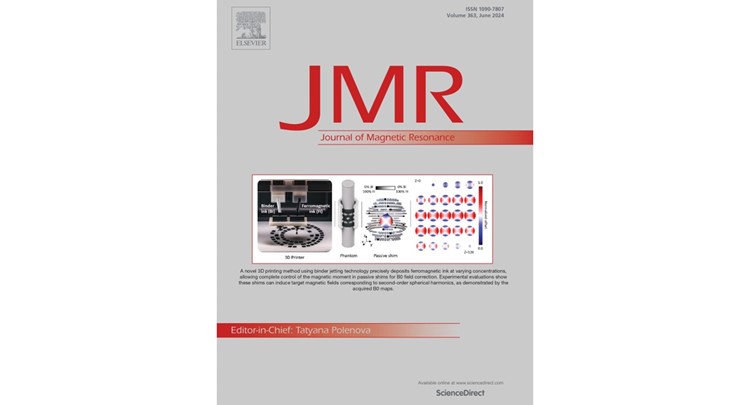
A visualization of our paper '3D printing of ferromagnetic passive shims for field shaping in magnetic resonance imaging' on the cover of Journal of Magnetic Resonance!
Find the article here or on the publication page of the website.
3D printing of ferromagnetic passive shims for field shaping in magnetic resonance imaging
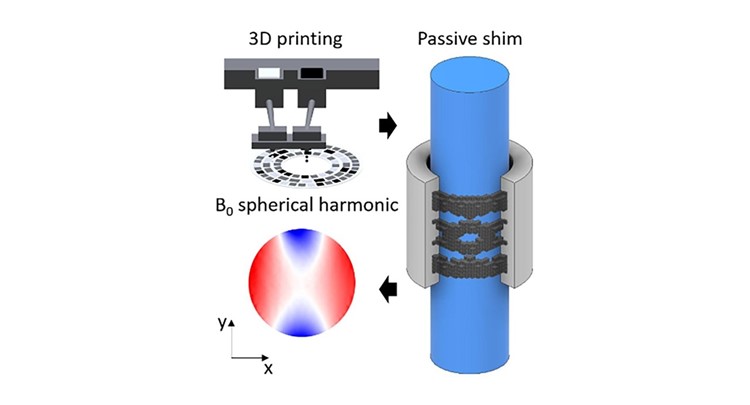
Magnetic Resonance Imaging (MRI) often encounters image quality degradation due to magnetic field inhomogeneities. Conventional passive shimming techniques involve the manual placement of discrete magnetic materials, imposing limitations on correcting complex inhomogeneities. To overcome this, we propose a novel 3D printing method utilizing binder jetting technology to enable precise deposition of a continuous range of concentrations of ferromagnetic ink. This approach grants complete control of the magnitude of the magnetic moment within the passive shim enabling tailored corrections of B0 field inhomogeneities. By optimizing the magnetic field distribution using linear programming and an in-house written Computer-Aided Design (CAD) generation software, we printed shims with promising results in generating low spherical harmonic corrections.
Experimental evaluations demonstrate feasibility of these 3D printed passive shims to induce target magnetic fields corresponding to second-order spherical harmonic, as evidenced by acquired B0 maps. The electrically insulating properties of the printed shims eliminate the risk of eddy currents and heating, thus ensuring safety. The dimensional fabrication accuracy of the printed shims surpasses previous methods, enabling more precise and localized correction of subject-specific inhomogeneities. The findings highlight the potential of binder-jetted 3D printed passive shims in MRI shimming as a versatile and efficient solution for fabricating passive shims, with the potential to enhance the quality of MRI imaging while also being applicable to other types of Magnetic Resonance systems.
Check out a visualization of this article on JMR cover!
More information can be found here, or on our publication page.
From Grayscale Photopolymerization 3D Printing to Functionally Graded Materials

Functionally graded materials (FGMs) have spatial variations in structure or composition that result in gradients in their mechanical, thermal, swelling, or other properties. FGMs have garnered significant research interest because of their extensive applications in areas such as biomedical implants, sensors, and soft robotics. Recently, grayscale photopolymerization 3D printing has emerged as a promising technology for crafting complex and high-resolution FGMs.
This comprehensive work delves into various grayscale photopolymerization 3D printing techniques, offering insights into their ability to precisely control printing exposure energy and polymerization degree, which in turn influence material properties. Furthermore, this work highlights diverse applications of grayscale vat-photopolymerization 3D printing. Finally, it offers perspectives on ways to enhance grayscale photopolymerization 3D printing, with a focus on improving printing feedstocks and grayscale strategies.
More information can be found here, or on our publication page
3D Printed Power Source for Point-of-Care Diagnostics @Advanced Engineering Materials!

Point-of-care (POC) devices require more advanced detection techniques than those currently available to achieve enhanced quantification and sensitivity. Incorporating a micro power supply could be a viable solution to enable the implementation of these techniques. In recent years, paper-based microfluidic galvanic cells (μGCs) have emerged as promising disposable power sources; however, the fabrication process remains labor intensive.
This study demonstrates the potential of three-dimensional printing as a novel fabrication method for μGCs. The autonomous μGCs are fabricated using a powder-based 3DPed method, resulting in a porous body in which capillary forces enable the coflow of redox-active solutions. As a proof of concept, a handheld glucometer is powered by coupling four μGCs in series.
More information can be found here, or on our publication page
Polymorphism and orientation control of copper-dicarboxylate MOF thin films through vapour- and liquid-phase growth @Cryst. Eng. Comm.!
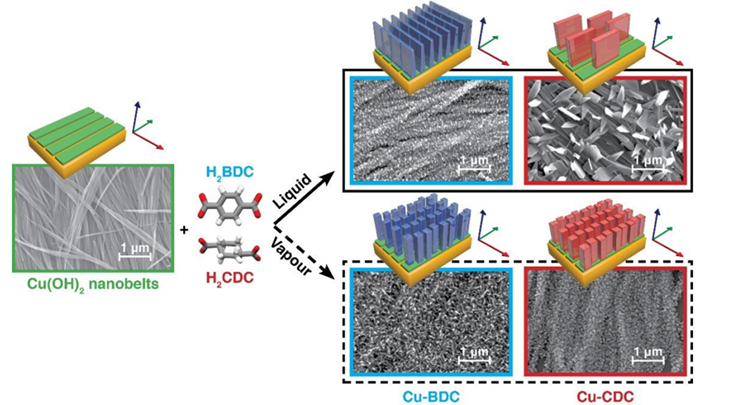
Precise control over the crystalline phase and crystallographic orientation within thin films of metal-organic frameworks (MOFs) is highly desirable. Here, we report a comparison of the liquid- and vapour-phase film deposition of two copper-dicarboxylate MOFs starting from an oriented metal hydroxide precursor.
X-ray diffraction revealed that the vapour- or liquid-phase reaction of the linker with this precursor results in different crystalline phases, morphologies, and orientations. Pole figure analysis showed that solution-based growth of the MOFs follows the axial texture of the metal hydroxide precursor, resulting in heteroepitaxy. In contrast, the vapour-phase method results in non-epitaxial growth with uniplanar texture only.
More information can be found here, or on our publication page
Vapor-assisted synthesis of the MOF-74 family @Dalton Trans.!

In this work, we investigate the vapor-assisted synthesis of the metal-organic framework MOF-74 starting from three metal oxides (ZnO, CoO, and MgO). Depending on the nature of the added vapor (H2O, DMF, DMSO), the metal oxide, and the temperature, the outcome of the reaction can be directed towards the desired porous phase.
Ex situ and in situ XRD measurements reveal the formation of an intermediate phase during the reaction of MgO with H4dobdc, while the MOF-74 phase forms directly for ZnO and CoO. The reduced CO2 uptake of the resulting materials compared to solvothermally prepared MOFs might be offset by the convenience of the presented route and the promise of a high space time yield.
More information van be found here, or on our publication page.
Digital halftoning for printer-independent SLA of functionally graded materials @Cell Rep. Phys. Sci.!
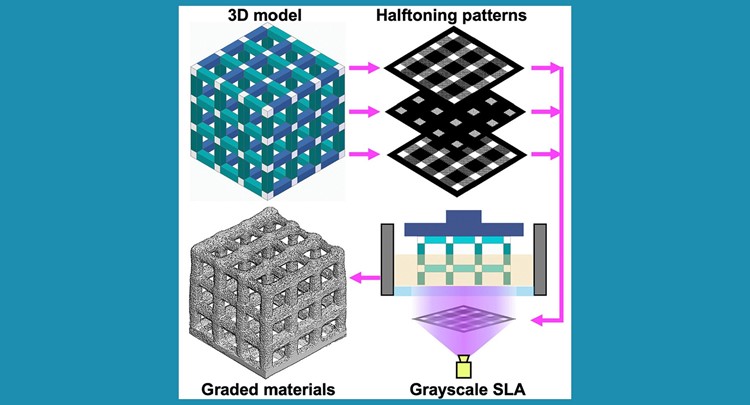
Grayscale masks have been applied in high-end stereolithography (SLA) 3D printers to spatially define the degree of photopolymerization and fabricate objects with graded properties. However, this approach cannot be applied in many commonly used projection SLA printers that can only handle 1-bit slices.
Based on dithering techniques and image-processing algorithms, we developed a digital halftoning approach to generate universally printable files consisting only of black and white pixels arranged to mimic the ‘‘true’’ grayscale levels. Using this approach, any SLA printer can be used to control the irradiation dose and the degree of photopolymerization in each printed layer. As proof of concept, we report various objects with graded properties using different commercial printers. This universal fabrication strategy will open a new window for engineers and scientists to explore grayscale SLA prints.
More information can be found here, or on the publication page.
Thin film capacitor geometries for VOC detection @ ACS Sensors!
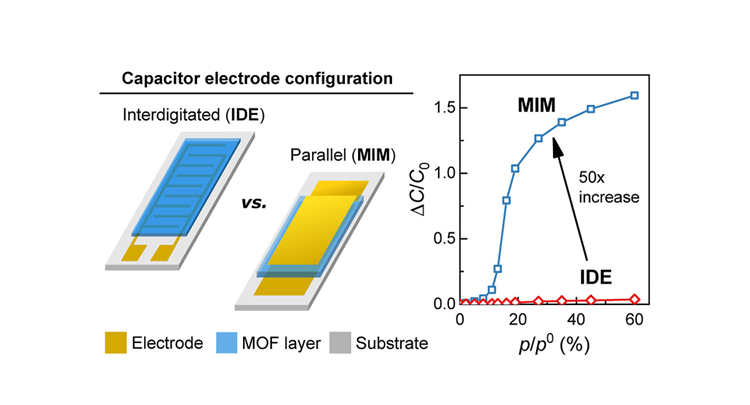
Their chemical diversity, uniform pore sizes, and large internal surface areas make metal−organic frameworks (MOFs) highly suitable for volatile organic compound (VOC) adsorption. In this work, we compare two geometries of capacitive VOC sensors that use the MOF material ZIF-8 as an affinity layer. When using a permeable top electrode (thickness < 25 nm), the metal−insulator−metal sandwich configuration exhibits superior sensitivity, an improved detection limit, and a smaller footprint than the conventional interdigitated electrode layout. Moreover, the transduction of VOC adsorption in ZIF-8 via MIM capacitors is more sensitive to polar VOCs and provides better selectivity at high loadings than gravimetric and optical transductions.
More information can be found here, or on the publication page of our website.
SLA 3D printing of graded porous materials @Cell Reports Physical Science!
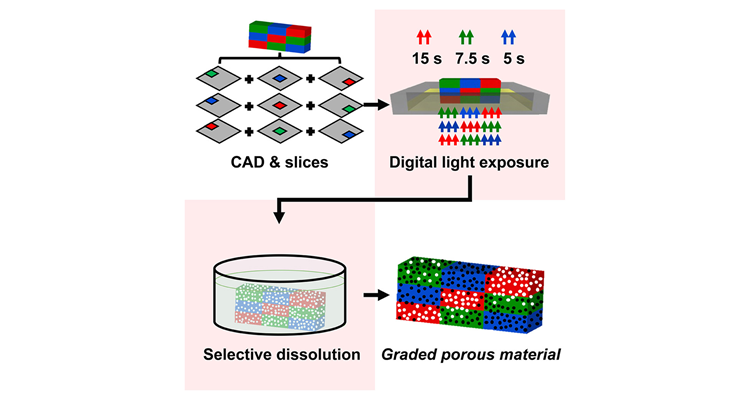
Graded porous materials (GPMs) with fine pore sizes (<50 μm) and gradient porosity are used in diverse fields such as biomedical implants, sensors, and soft robotics. Stereolithography (SLA) 3D printing has created new possibilities for fabricating intricate porous materials due to its high speed and excellent resolution. Nevertheless, for many commonly used low-cost SLA printers, the traditional SLA process is not ideally suited to print GPMs since only a single material feedstock is used for the entire print.
In this paper, we demonstrate how this limitation can be overcome by using a composite feedstock consisting of a photoresin and a polymeric filler in combination with voxel-level digital control over the light exposure. Based on this strategy, spatial control over the porosity, mechanical properties, and swelling behavior within the SLA prints is achieved. We expect that this scalable fabrication strategy will contribute to a variety of applications that require GPMs.
More information can be found here, or on the Publication page.
Ceramic foams through 3D-printed templates @Adv. Eng. Mater.!

In this paper, powder-based three-dimensional (3D) printing was combined with sacrificial templating to realize highly porous yttria-stabilized ZrO2 (YSZ) ceramic foam objects with well-defined geometries. The porous sacrificial template is 3D-printed using poly(methyl methacrylate) powder. Various methods are evaluated to optimize ceramic slurry infiltration into the 3D-printed template and subsequent burn-out. The optimized method yields ceramic foam objects with an open porosity of > 66% and replicates the geometry of the 3D-printed template with high fidelity.
More information here, or on the publication page!